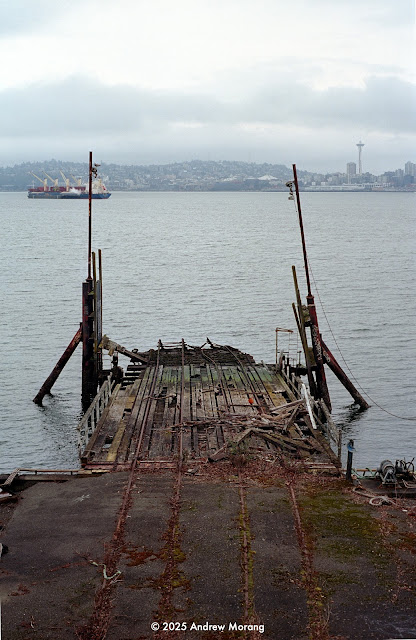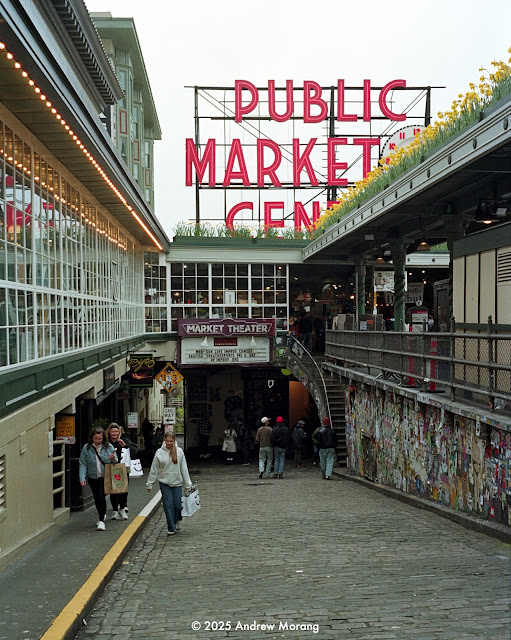Blog Note: I published this a few weeks ago but withdrew it so that I could post timely pictures of the April 5, 2025, Hands Off protest at the Washington State Capitol. Here is the Volkswagen again.
Ankara, Turkey
In the mid-1960s, my dad worked in Ankara, Turkey. He wanted to buy a car and ordered a 1965 Volkswagen Variant (known as the Squareback in the USA market). This was Volkswagen's Type 3 design, their attempt to cater to larger families with a slightly upmarket car compared to their classic Beetle.
I am not sure why my dad did not choose the bus. I could see him in that kind of machine. But he opted for the little Squareback.
 |
| Small, medium, and large (not to scale) |
 |
| 1969 brochure, but the car looked the same as the 1965 model |
I do not know if there were Volkswagen dealers in Turkey. I think he had never driven this type of car as a test. Volkswagen delivered the car to the docks in Istanbul. Awaiting delivery was common overseas mid-century. Dealers did not have parking lots covered with cars as in USA just waiting for you to drive one away. Normally, you paid a deposit, they ordered your car, and it was delivered weeks or months later.
My dad was energetic. He took the train to Istanbul, picked up his shiny new car and drove it back to Ankara. How he negotiated the paperwork, I will never know. He had lived all over the world and was not intimidated by unusual bureaucratic issues. (But if he were still alive, how would he fare in modern USA, with every institution designed to make life clumsy, irritating, and inconvenient for the customer?)
 |
| Hanging around, Farabi Sk., Çankaya District, Ankara, Turkey, 1965 |
 |
| At the Grand National Assembly, Ankara, 1965 |
This VW came with a 4-speed manual transmission, manual steering, manual drum brakes, and an almost non-existent heat system. The 54hp engine was a 4-cylinder pancake design mounted below the back deck, which left plenty of storage space. With the back seat down, you had a flat platform about 6 ft long. The car ran on very low octane petrol, which was perfect for Turkish use. The electrical system was 6 volt. There were no seat belts, but he added them in the USA.
We lived in an apartment in the Çankaya District, which is still an exclusive neighborhood with embassies, museums, theatres, and better apartments. I spent part of 7th grade at the George C. Marshall Regional High School. We explored and visited Cappadocia, when it was a quiet backwater in central Anatolia.
In late 1965, my dad's project in Ankara ended. We packed up, and, with me as passenger, drove the little Squareback west to Istanbul, and then on to Athens. I recall the back was well-filled with possessions. From Athens, on to Patras, and then the ferry boat to Brindisi. Then Rome and, finally, Genoa. From Genoa, it went by ship to Boston. We flew to London and then took a Boeing 707 PanAm flight across the ocean to Boston.
Belmont, Massachusetts
 |
| Living on Winn Street, Belmont, Massachusetts, 1969 |
My dad used the Squareback as his commuter car. We took summer trips to Nova Scotia and Ontario. I took driver education at Belmont High School in some behemoth Ford Galaxy, but practiced in the little Squareback. The car carried my friends and me on many hiking trips to the White Mountains of New Hampshire.
 |
| Living in the snow, Belmont, Massachusetts, 1969 |
Pacific Northwest
In late 1971, another adventure. We packed my possessions and drove west to Seattle. The poor little 54 HP engine could barely manage 70 mph on a cool damp morning on the Great Plains. By the heat of midday, 65 mph was maximum with the accelerator floored.
My dad left the Squareback with me and flew home to Massachusetts. I lived in the dorms and parked in the parking garages underneath Lander and McMahon Halls. Covered parking!
 |
| On the Bremerton-Seattle Ferry, Washington, 1973 |
 |
| Somewhere at Mount Rainier, January 1974 |
 |
| Stevens Pass, Washington, January 1974 |
The little Squareback took my friends and me on many adventures in the Northwest, to Crater Lake, Mount Rainier, and Mount Saint Helens (before it blew up). With the rear engine over the drive wheels, that Squareback could go up muddy logging roads or snowy passes in the Cascades. I also did a roundtrip to and from Boston in summer of 1972.
One trip while cross-country skiing at Snoqualmie Pass, someone broke in and stole the front seats. The police gave me a crate to sit on, and I drove back to Seattle. I bought better condition high-back seats at a junk yard.
If I was camping alone, I could sleep at an angle in the back and close the hatch. But with two people, we had to keep the hatch open at the bottom and let our feet stick out. If it was cold, our breath would condense all over the windows, and it was a mess to clean off the windows considering the almost non-existent defrost system.
The heat came from the engine fan via a tube in the middle of the car. Two levers controlled the air flow. One lever opened the vents to the floor. That was reasonably effective if the engine was hot and you had been driving a while. A second lever was supposed to direct air up to the windshield, but very little warm air made it to the glass surface. In other markets, Volkswagen sold a petrol powered heater, but I do not know if this was available in USA.
I sold the car to a friend. and moved on. I wish I had bought a classic Volvo station wagon then. That would have been a smart move.
The Squareback had a sad end. My friend and his wife were moving across country. The Squareback rolled down an embankment in some reservation. When my friend last saw it, tribal members were stripping wheels, seats, and parts from the car. I wonder if the hulk is still down there? So it goes....
 |
| Another treasure at Tom Tom's museum, Moab, Utah |
In the last two decades, I have seen maybe 2 or 3 examples of a Squareback on the road. I saw some sad examples in Tom Tom's VW disposal yard in Moab, Utah. No one seems to care about restoring VW's Type 3 cars. I see a surprising number of restored Type 1 (Beetle) and Type 2 (bus) in Olympia, but no Type 3s. It was reasonable technology that did its job a long time ago.























































